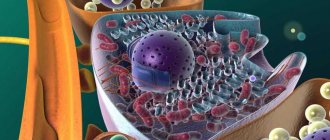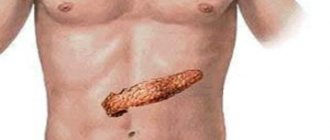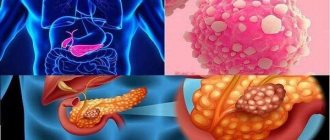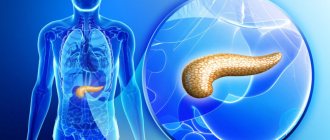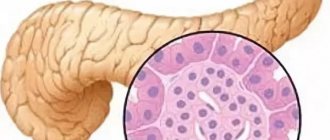The purpose of the islets of Langerhans
The main part of the cells of the pancreas (PG) produces enzymes that promote digestion.
The function of island clusters is different - they synthesize hormones, so they are classified as the endocrine system. Thus, the pancreas is part of two main systems of the body - digestive and endocrine. The islets are microorgans that produce 5 types of hormones.
Most of the pancreatic groups are located in the tail of the pancreas, although chaotic, mosaic inclusions involve all exocrine tissue.
OBs are responsible for regulating carbohydrate metabolism and supporting the functioning of other endocrine organs.
Where is the organ located?
The pancreas in a healthy person is located directly behind the stomach, in the posterior abdominal region in close proximity to the liver, and has a complex anatomy. The mass of the organ in an adult is approximately ninety grams.
Among the components of the gland are the head (where the uncinate process is located), as well as the body and tail of the organ. Most of the gland is located in the left hypochondrium, but its head makes a projection into the space on the left above the navel.
Histological structure
Each island is an independently functioning element. Together they form a complex archipelago, which is made up of individual cells and larger formations. Their sizes vary significantly - from one endocrine cell to a mature, large islet (>100 µm).
In pancreatic groups, a hierarchy of cell arrangement is built, there are 5 types of them, all perform their role. Each island is surrounded by connective tissue and has lobules where capillaries are located.
In the center there are groups of beta cells, along the edges of the formations there are alpha and delta cells. The larger the islet, the more peripheral cells it contains.
The islets do not have ducts; the hormones produced are excreted through the capillary system.
Types of endocrine cells of the pancreas
Islet clusters produce several types of cellular structures; they are united by the fact that they all take part in the production of hormones and peptides.
Most of the islets are made up of beta cells, which are located in the central part of each lobule. Beta cells are of particular importance because they are responsible for the hormone insulin, which they themselves produce.
No less important are the alpha cells of the pancreas, which make up a fourth of the islet cluster and produce glucagon, which acts as an insulin antagonist.
PP and delta cells formed in the periphery provide constant production of peptide and somatostatin, necessary for the regulation of carbohydrate metabolism.
A characteristic feature of the islets of Langerhans is their difficult regeneration, the process of which is very difficult for them to undergo. In this regard, any damage to these structures is fraught with the loss of their normal functionality, which is almost impossible to restore.
Types of cells
Different groups of cells produce their own type of hormone, regulating digestion, lipid and carbohydrate metabolism.
- Alpha cells . This group of OBs is located along the edge of the islets; their volume makes up 15-20% of the total size. They synthesize glucagon, a hormone that regulates the amount of glucose in the blood.
- Beta cells . They are grouped in the center of the islets and make up most of their volume, 60-80%. They synthesize insulin, about 2 mg per day.
- Delta cells . They are responsible for the production of somatostatin, they range from 3 to 10%.
- Epsilon cells . The amount of the total mass is not more than 1%. Their product is ghrelin.
- PP cells . The hormone pancreatic polypeptide is produced by this part of the OB. They make up up to 5% of the islands.
Over the course of life, the proportion of the endocrine component of the pancreas decreases - from 6% in the first months of life to 1-2% by the age of 50.
What hormones does the pancreas produce?
Every year the possibilities of science expand information about the role of pancreatic hormones, allowing us to identify new forms, their influence and interaction. The pancreas secretes hormones involved in metabolism in the body:
- insulin;
- glucagon;
- somatostatin;
- pancreatic polypeptide;
- gastrin.
Until some time, the substance C-peptide was classified as a pancreatic hormone. It was then proven that it represents a piece of the insulin molecule that was torn off during synthesis. The determination of this substance remains important when analyzing the detection of the amount of insulin in the blood, since its volume is proportional to the main hormone. It is used in clinical diagnosis.
In the endocrine part of the gland, cells are divided into four main types:
- alpha cells - make up up to 20% of the total mass, glucagon is synthesized in them;
- beta cells are the main type, they account for 65–80%, produce the necessary insulin, these cells are characterized by gradual destruction as a person ages, their number decreases with old age;
- delta cells - occupy approximately 1/10 of the total number, they produce somatostatin;
- PP cells - found in small numbers, differ in their ability to synthesize pancreatic polypeptide;
- G-cells - produce gastrin (together with the gastric mucosa).
Hormonal activity
The hormonal role of the pancreas is great.
Active substances synthesized in small islets are delivered to the organs by the bloodstream and regulate the metabolism of carbohydrates:
- The main job of insulin is to minimize blood sugar levels. It increases the absorption of glucose by cell membranes, accelerates its oxidation and helps to store it in the form of glycogen. Violation of hormone synthesis leads to the development of type 1 diabetes. In this case, blood tests show the presence of antibodies to beta cells. Type 2 diabetes develops when tissue sensitivity to insulin decreases.
- Glucagon performs the opposite function - it increases sugar levels, regulates glucose production in the liver, and accelerates the breakdown of lipids. The two hormones, complementing each other’s action, harmonize the content of glucose, a substance that ensures the vital activity of the body at the cellular level.
- Somatostatin slows down the action of many hormones. In this case, there is a decrease in the rate of absorption of sugar from food, a decrease in the synthesis of digestive enzymes, and a decrease in the amount of glucagon.
- Pancreatic polypeptide reduces the number of enzymes and slows down the release of bile and bilirubin. It is believed that it stops the consumption of digestive enzymes, preserving them until the next meal.
- Ghrelin is considered a hunger or satiety hormone. Its production signals the body about the feeling of hunger.
The amount of hormones produced depends on the glucose obtained from food and the rate of its oxidation. As its amount increases, insulin production increases. Synthesis starts at a concentration of 5.5 mmol/l in blood plasma.
Not only food intake can trigger insulin production. In a healthy person, the maximum concentration is observed during periods of severe physical exertion and stress.
The endocrine part of the pancreas produces hormones that have a decisive influence on the entire body. Pathological changes in the OB can disrupt the functioning of all organs.
Video about the tasks of insulin in the human body:
Main function of beta cells
The pancreas metabolizes carbohydrates and produces the required enzymes involved in the digestive system. The main function of the gland is to maintain the indicator for a normal state. The pancreas is involved in exocrine and endocrine secretion immediately, which allows the hormone to be included in the circulatory system and the small intestine.
Sugar levels are regulated by the hormonal system. Only 3% of the cells of the total organ volume produce insulin with glucagon. They can both increase sugar and lower it.
The importance of the endocrine system lies in the production of secretions necessary for the normal functioning of the liver with the gland involved in the digestive tract. The enzymes present in the juice are capable of separating organic compounds, which are then broken down into enzymes and absorbed by the intestines. The exocrine structure is more developed and covers up to 96% of the size of the entire organ.
The pancreas has a lobular structure. In the middle of the lobules there are arteries, nerves, and channels that collect secretions and transport them to the main duct. So in which zone is insulin produced in the pancreas?
pancreas
The islets of Langerhans are responsible for endocrine function. They contain a variety of cell types.
- A – cell that produces glucagon.
- B - producing insulin.
- D – somatostatin.
- G – gastrin.
- Pips cells develop a small amount of pancreatic polypeptide.
The bulk of insulin is produced in beta cells. The mechanism of formation of pancreatic hormone in the body is quite simple. The hormone begins to be actively produced when the amount of carbohydrates in the biological fluid increases. The products also stimulate insulin production. Therefore, any product entering the stomach helps trigger the synthesis of a hormonal element.
When the functionality of an organ is impaired, due to a lack of hormone, the patient will face diabetic disease. Doctors and scientists are still figuring out how the hormone is synthesized to regulate the procedure.
Initially, the indicator is secreted by beta cells and then transported into the network of ducts of the Golgi apparatus. Further processing takes place there. In the cavity of the apparatus, which is designed to accumulate and produce various substances, the peptide is removed. This is how insulin appears.
Then it is packaged into secretory granules, where it accumulates and remains until hyperglycemia occurs. If sugar rises, insulin is required, and beta cells release it into the bloodstream.
features of the pancreas
Glucose, which is not immediately absorbed, is bound into glycogen molecules in the liver, muscles, and subcutaneous fat. The body uses up these supplies if the last snack was a long time ago, or after increased physical activity.
Glucagon also takes part in the metabolic phenomenon, which leads to a signal to liver cells to supply glucose from their reserves into the blood.
Treatment
Treating the pancreas at home is strictly prohibited. At the first signs of illness, you should consult a doctor or call an ambulance at home, followed by hospitalization. In this case, medications or procedures may be prescribed depending on the stage of development of the disease.
Many complex destructive pathologies are the result of lack of treatment or improper therapy of pancreatitis. If they are present, if conservative treatment does not produce results, surgery may be prescribed. Within reasonable limits and with the recommendation of the attending physician, traditional medicine can also be used.
